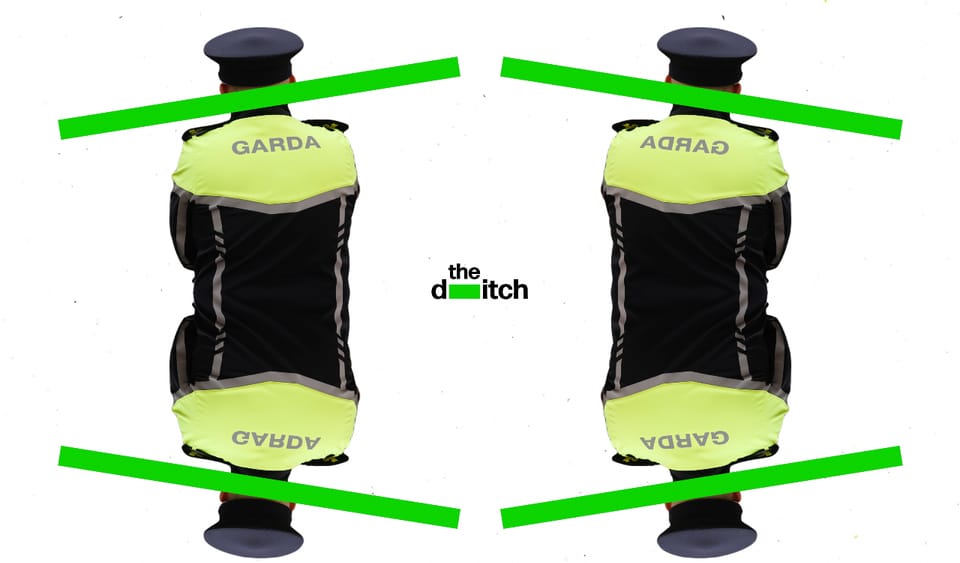By Roman Shortall. Originally published in The Ditch's State Failures.
The Garda Síochána will succeed not by force of arms or numbers, but on their moral authority as servants of the people
- Michael Staines, first garda commissioner, 1922
In 2002 footage emerged of gardaí viciously assaulting people engaged in a peaceful Reclaim the Streets protest on May Day in Dublin city centre. One of these guardians of the peace was captured on video using his baton to beat a protester over the head. His display earned him the nickname Robocop.
Two decades later, Robocop is now a member of the Expert Advisory Board to the Code of Ethics and Cultural Adjustment Steering Committee in An Garda Síochána. His career illustrates what accountability means in the gardaí, the century-old police force with an entrenched culture of permissiveness that starts at the top and cascades downwards. Two garda commissioners in the past decade alone were forced to resign in disgrace.
The Irish commentariat is unhealthily deferential to the gardaí, somehow convincing themselves that the guards’ litany of historical scandals is the work of a few miscreants as opposed to the result of a secretive, discredited and dangerous organisation. Earlier this year, the public was treated to a now infamous display of this gardaphilia when one outspoken national newspaper editor almost combusted on live television over artwork that depicted gardaí assisting at an eviction, something they do frequently and often violently.
An Garda Síochána is a police force whose former commissioner, Martin Callinan, coordinated a vicious campaign against one of its own – a whistleblower who believed in the rule of law – that involved spreading malicious untruths about him to the media and public representatives. It is an organisation that has planted drugs on innocent people and stitched others up for murders they didn’t commit. It even colluded with the church to protect those who abused children. More recently, its senior members quashed speeding tickets for the connected. To ignore such wrongdoing when discussing policing in Ireland is embarrassing and irresponsible – and arguably a form of disinformation.
Among the guards’ most fervent cheerleaders is a small but influential cabal of crime journalists who act as a vehicle for garda management to disseminate stories with favourable narratives in exchange for access to confidential information. Some socialise personally with senior gardaí. This quid pro quo is rarely challenged or even acknowledged. It’s just the norm for senior cops to leak confidential information to discredit whistleblowers, defendants and even witnesses.
The aversion to holding An Garda Síochána to account stymies victims of garda wrongdoing, with the most egregious example being the catalogue of unexplained suspicious deaths of young working class boys and men in garda custody.
'The Wheelocks weren’t middle-class, animal-torturing landowners personally known to Humphreys'
Among the list of those who died in unexplained circumstances following a period of detention in a garda cell is one name that is more recognisable than the others, a name synonymous with both the culture of garda cover-ups, as well as a family’s determination in seeking justice: Terence Wheelock.
Officially, Terence hanged himself in a Store Street Garda station cell in 2005 using the cord from his tracksuit bottoms attached to a fixture which was “counter-sunk” into a wall. He died in hospital weeks later. Unofficially, many believe, not unreasonably, that gardaí were responsible for his death. Terence lived in Summerhill, not Killiney Hill. The Wheelocks aren’t the sort of people who can put in a call to their local senior garda to have penalty points dropped or to send out a squad car to help them evict tenants.
The Wheelocks’ north inner city Dublin background was a factor in how they were treated by An Garda Síochána in the aftermath of Terence’s death. It meant that gardaí felt comfortable enough to terrorise and intimidate them in their own home, abhorrent treatment not unique to them but rather how gardaí have policed disadvantaged areas – something that successive governments refuse to address.
Fine Gael and Fianna Fáil TDs don’t raise the Wheelock family’s plight in the Dáil. Instead it's been left to opposition deputies who themselves grew up in the inner-city, most notably Gary Gannon and Bríd Smith, to lead the call for the state to establish an appropriate independent forum to probe the facts surrounding Terence’s tragic death. The state has refused to reconsider its position despite the emergence of new evidence since the 2010 GSOC report into Terence’s detention at Store Street garda station.
“What can I say, but that this is another very sad situation for a family,” said acting justice minister Heather Humphreys in June 2021 when she rejected a request from TD Paul Murphy to establish a public inquiry into Terence’s death. Her faux compassion was only surpassed in its vulgarity by the latter part of her Dáil contribution where instead of offering solutions to the Wheelock’s legitimate requests she used the opportunity to talk about refurbishment projects carried out in garda station cells over the preceding decade.
Humphreys, who as agriculture minister intervened to block a 2020 prosecution against a farmer charged with animal cruelty, told Murphy that “the independence of GSOC and the judiciary is a key part of our democracy and I cannot interfere in any way”. The Wheelocks weren’t middle-class, animal-torturing landowners personally known to Humphreys. She wouldn’t help.
Senator Lynne Ruane, who once lived in the same estate as Terence’s family, raised their cause in the Seanad that same month. She said something that the state and its defenders don’t want to hear. “I would have experienced violence at the hands of gardaí. Nobody's positive experience with authority should ever negate the negative experience of other people. They can both exist within the same institution and in the same space. We need to be able to talk about this matter.” On the other hand Simon Harris – most of whose interactions with gardaí involve his being driven around in a luxury German car – while acting justice minister said he wholeheartedly trusts the operational judgement of An Garda Síochána.
Terence Wheelock isn’t the only youth to have died following injuries sustained while in garda custody. There are many more, some children.
Brian Rossiter, aged 14, died in September 2002 after being found unresponsive in Clonmel garda station shortly after he and his two friends were allegedly assaulted during their arrest by local gardaí. Although the circumstances surrounding Rossiter’s death are more complicated than those of Wheelock’s, there is evidence to support the suspicion that garda wrongdoing played a role in his death.
Like the Wheelock family, the Rossiters had to fight for some level of justice. They too had to face down gardaí who lied to protect themselves and their colleagues. One of these less than truthful gardaí now holds a senior position in An Garda Siochána.
Whatever “moral authority” An Garda Siochána might have had when its first commissioner, Michael Staines, said those words in 1922 has long since left in the eyes of the people in disadvantaged areas who have been the primary recipients of police violence over the decades. Why should Terence Wheelock’s family, friends and neighbours submit to the authority of An Garda Síochána? Without genuine accountability and attrition, the pain inflicted by gardaí on underprivileged communities will remain permanent, passed down through future generations.
Roman Shortall is co-founder of The Ditch.


